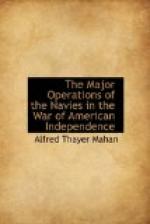The arrival of de Ternay’s seven ships at Newport was more than offset by a British reinforcement of six ships of the line under Rear-Admiral Thomas Graves which entered New York on July 13th,—only one day later. Arbuthnot’s force was thus raised to ten of the line, one of which was of 98 guns. After Rodney had come and gone, the French division was watched by cruisers, resting upon Gardiner’s Bay,—a commodious anchorage at the east end of Long Island, between thirty and forty miles from Rhode Island. When a movement of the enemy was apprehended, the squadron assembled there, but nothing of consequence occurred during the remainder of the year.
The year 1780 had been one of great discouragement to the Americans, but the injury, except as the lapse of time taxed their staying power, was more superficial than real. The successes of the British in the southern States, though undeniable, and seemingly substantial, were involving them ever more deeply in a ruinously ex-centric movement. They need here only to be summarised, as steps in the process leading to the catastrophe of Yorktown,—a disaster which, as Washington said, exemplified naval rather than military power.
The failure of d’Estaing’s attack upon Savannah in the autumn of 1779[89] had left that place in the possession of the British as a base for further advances in South Carolina and Georgia; lasting success in which was expected from the numbers of royalists in those States. When the departure of the French fleet was ascertained, Sir Henry Clinton put to sea from New York in December, 1779, for the Savannah River, escorted by Vice-Admiral Arbuthnot. The details of the operations, which were leisurely and methodical, will not be given here; for, although the Navy took an active part in them, they scarcely can be considered of major importance. On the 12th of May, 1780, the city of Charleston capitulated, between six and seven thousand prisoners being taken. Clinton then returned to New York, leaving Lord Cornwallis in command in the south. The latter proposed to remain quiet during the hot months; but the activity of the American partisan troops prevented this, and in July the approach of a small, but relatively formidable force, under General Gates, compelled him to take the field. On the 16th of August the two little armies met at Camden, and the Americans, who were much the more numerous, but largely irregulars, were routed decisively. This news reached General Washington in the north nearly at the same moment that the treason of Benedict Arnold became known. Although the objects of his treachery were frustrated, the sorrowful words, “Whom now can we trust?” show the deep gloom which for the moment shadowed the constant mind of the American Commander-in-Chief. It was just at this period, too, that Rodney arrived at New York.




